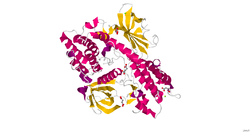GAK (protein)
| View/Edit Human | View/Edit Mouse |
Cyclin G-associated kinase (GAK) is a serine/threonine kinase that in humans is encoded by the GAK gene.[5][6]
Function
In all eukaryotes, the cell cycle is governed by cyclin-dependent protein kinases (CDKs), whose activities are regulated by cyclins and CDK inhibitors in a diverse array of mechanisms that involve the control of phosphorylation and dephosphorylation of Ser, Thr or Tyr residues. Cyclins are molecules that possess a consensus domain called the 'cyclin box.' In mammalian cells, 9 cyclin species have been identified, and they are referred to as cyclins A through I. Cyclin G is a direct transcriptional target of the p53 tumor suppressor gene product and thus functions downstream of p53. GAK is an association partner of cyclin G and CDK5.[5]
Cyclin G-associated kinase received its name because it immunoprecipitated with cyclin G though it now appears to not be associated with it. Cyclin G-associated kinase is homologous in function to the protein auxilin which when in association with Hsc70 uncoats clathrin in neuronal cells. However, the location of Cyclin G-associated kinase is not in the brain but near the trans-Golgi network of non-neuronal cells such as those found in the liver and testes. GAK is also known to be associated with focal adhesions though the exact relationship between the two is unknown.[7]
Structure
A structure of GAK was determined using X-ray diffraction to a resolution of 2.10 Å.[8]
Cyclin G-associated kinase is a two domain cystolic protein. The domain of interest is the C-terminal domain which consists of three subdomains such as a C-terminal J domain, a clathrin-binding domain, and a tension-like N-terminal domain. The other domain is the N terminal kinase domain which is a functional Ser/Thr protein kinase. The N-terminal kinase domain is able to phosphorylate histone H1. The subdomain tension-like N terminal function has not yet determined, though the domain shares high homology to the tumor suppressant PTEN. The key characteristic is the cysteine group which is required for phosphorylation; however the tension-like N terminal subdomain is absent of some important functional residues that PTEN has. The C-terminal J domain is responsible for the interaction with Hsc70, which is a molecular chaperone responsible for the uncoating of clathrin-coated vesicles during endocytosis. The clathrin-binding domain gathers clathrin into baskets. At pH 7 GAK allows Hsc70 to uncoat clathrin baskets and at pH 6 Hsc70 binds clathrin baskets without uncoating clathrin. Without taking into account GAK’s kinase domain, GAK is 43% identical to auxilin, a neuronal cell uncoating clathrin cofactor, in its amino acid composition. GAK is 57% homologous to auxilin if conserved residues are included in the comparison. Though similar domains of these two molecules suggest and have similar functions, the proteins carry these functions out in different manners. GAK initiates the assembly of clathrin baskets stoichiometrically, but at the different pHs it will either bind the Hsc70 to the baskets or induce the Hsc70 to uncoat the clathrin baskets catalytically which is one difference between auxilin and GAK. This catalytic route explains why less GAK than auxilin is needed to carry out a similar function.[7]
References
- ↑ "Diseases that are genetically associated with GAK view/edit references on wikidata".
- ↑ "Drugs that physically interact with Cyclin-G-associated kinase view/edit references on wikidata".
- ↑ "Human PubMed Reference:".
- ↑ "Mouse PubMed Reference:".
- 1 2 "Entrez Gene: cyclin G associated kinase".
- ↑ Kimura SH, Tsuruga H, Yabuta N, Endo Y, Nojima H (September 1997). "Structure, expression, and chromosomal localization of human GAK". Genomics. 44 (2): 179–87. doi:10.1006/geno.1997.4873. PMID 9299234.
- 1 2 Kanaoka Y, Kimura SH, Okazaki I, Ikeda M, Nojima H (January 1997). "GAK: a cyclin G associated kinase contains a tensin/auxilin-like domain". FEBS Lett. 402 (1): 73–80. doi:10.1016/S0014-5793(96)01484-6. PMID 9013862.
- ↑ Zhang R, Hatzos-Skintges C, Weger A, Eswaran J, Fedorov O, King O, Von Delft F, Bountra C, Arrowsmith CH, Weigelt J, Edwards A, Knapp S, Joachimiak A, Midwest Center for Structural Genomics (MCSG) (2010). "Crystal structure of the human cyclin G associated kinase". To be Published. doi:10.2210/pdb3ll6/pdb.
Further reading
- Kanaoka Y, Kimura S, Okazaki I, Ikeda M, Nojima H (1997). "GAK: a cyclin G associated kinase contains a tensin/auxilin-like domain". FEBS Lett. 402 (1): 73–80. doi:10.1016/S0014-5793(96)01484-6. PMID 9013862.
- Zhang, R.; Hatzos-Skintges, C.; Weger, A.; Eswaran, J.; Fedorov, O.; King, O.; Von Delft, F.; Bountra, C.; Arrowsmith, C.H.; Weigelt, J.; Edwards, A.; Knapp, S.; Joachimiak, A. "Crystal structure of the human cyclin G associated kinase (GAK)".
- Tsvika Greener; Xiaohong Zhao; Hiroshi Nojima; Evan Eisenberg; Lois E. Greene (January 14, 2000). "Role of Cyclin G-associated Kinase in Uncoating Clathrin-coated Vesicles from Non-neuronal Cells". Journal of Biological Chemistry. 275 (1): 1365–1370. doi:10.1074/jbc.275.2.1365.
This article incorporates text from the United States National Library of Medicine, which is in the public domain.
